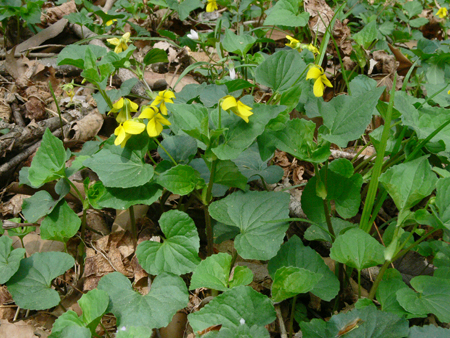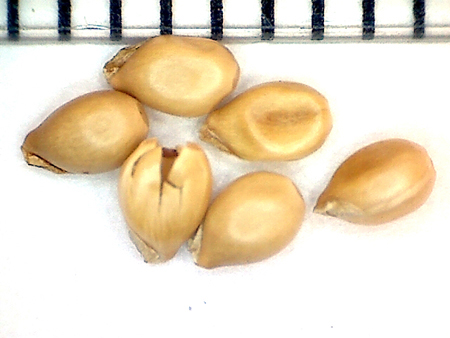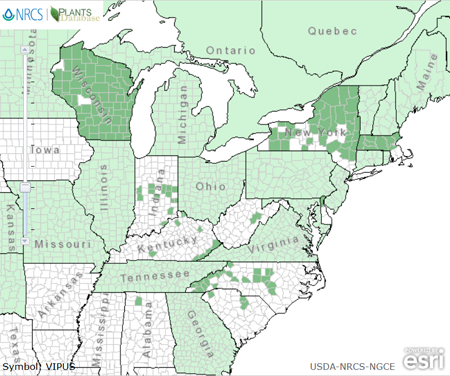Viola eriocarpa Schwein.
Common names:
Smooth Yellow Violet
Synonyms:
Viola eriocarpa Schwein., Amer. J. Sci. 5: 75. 1822; Viola pubescens Aiton var. eriocarpa (Schwein.) N.H.Russell, Sida 2: 78. 1965 [nomen superfluum]; Crocion eriocarpum (Schwein.) Nieuwl. & Kaczm., Amer. Midl. Naturalist 3: 214. 1914. TYPE: USA, [North Carolina, Salem, no date, Schweinitz s.n.], (type: PH00029084, JSTOR Global Plants image!). [No type specimen was cited in the protologue, but a sheet at PH is noted "Type collection" with two separate collections. PH00029084, annotated as coming from Salem, NC, bears the label "Viola scabriuscula NOBIS eriocarpa Herb. Schweinitz"; PH00029085 has the label "Viola pubescens V. scabriuscula N. W. Territory J. N. Nicollet 400" and is not a type. The PH00029084 specimen should be designated as a lectotype.]
Viola pubescens Aiton var. leiocarpa (Fernald & Wiegand) B.Boivin, Phytologia 15: 435. 1967; Viola pensylvanica Michx. var. leiocarpa (Fernald & Wiegand) Fernald, Rhodora 43: 617. 1941; Viola eriocarpa Schwein. f. leiocarpa (Fernald & Wiegand) Deam, Fl. Indiana: 691. 1940; Viola pubescens Aiton f. leiocarpa (Fernald & Wiegand) Farw., Pap. Michigan Acad. Sci. 2: 33. 1923 ["1922"]; Viola eriocarpa Schwein. var. leiocarpa Fernald & Wiegand, Rhodora 23: 275. 1921
Viola eriocarpa Schwein. var. typica Grover, Ohio J. Sci. 39: 145. 1939
Viola pubescens Aiton f. achlydophylla (Greene) Farw., Amer. Midl. Naturalist 12: 127. 1930; Crocion achlydophyllum (Greene) Kaczm., Amer. Midl. Naturalist 4: 74. 1915; Viola achlydophylla Greene, Pittonia 5: 87. 1902
Viola eriocarpa Schwein. var. sessilis Clute, Amer. Bot. (Binghamton) 30: 32. 1914
Crocion scabriusculum (Schwein. ex Torr. & A.Gray) Nieuwl. & Kaczm., Amer. Midl. Naturalist 4: 75. 1915; Viola scabriuscula (Torr. & A.Gray) Shafer, Ann. Carnegie Mus. 1(1): 27. 1901; Viola pubescens Aiton var. scabriuscula Schwein. ex Torr. & A.Gray, Fl. N. Amer. 1(1): 142. 1838
Viola dasyneura Greene, Leafl. bot. observ. 2(2): 96. 1910-1912
Description:
Caulescent perennials from thick rhizome, stems usually decumbent at base during chasmogamous flowering but becoming erect in fruit, commonly ≥ 2, ≤ 35 cm tall; stems, foliage and peduncles green, glabrous to sparsely (rarely moderately) hirtellous; leaves cauline and basal, basal leaves usually ≥ 2, cauline leaves well distributed along the stem; stipules free, narrowly ovate, entire or weakly erose; leaves ascending to spreading, leaf blades undivided, largest ≤ 64 × 73 mm, upper narrowly ovate to ovate and often short-acuminate, lower ovate to broadly so and acute, base subtruncate to cordate, margins serrate, eciliate or ciliate; chasmogamous flower ≤ 12 mm; calyx glabrous, eciliate or ciliate; lowest sepals linear-lanceolate to lanceolate, acute to obtuse; auricles short and entire, not elongating in fruit; corolla wholly yellow with purple-black lines at base of petals and purple-tinged on backs of petals; spur short-globose; lateral petals densely bearded with slightly clavate hairs, spurred petal glabrous; cleistogamous flowers produced after chasmogamous; capsule 7–13 mm, green drying tan or brown, unspotted, glabrous or densely tomentose; seeds 2.1–2.7 × 1.4–1.7 mm, medium orange-brown, unspotted; 2n=12.
Similar species:
In chasmogamous flower, the most likely species to be confused with this are yellow-flowered Viola glaberrima and Viola pubescens. It differs from both species in its multiple basal leaves and usually multiple stems declined at base; from Viola glaberrima in cauline leaf blades broader and truncate to subcordate at base; and from Viola pubescens in nearly glabrous to sparsely (rarely densely) hirsute foliage, leaves inserted along most of the stem length, and lanceolate to narrowly ovate stipules. In fruit, besides the above distinguishing traits, it can be separated from Viola canadensis and Viola rugulosa by the fewer coarser crenate-serrate teeth on the leaf blade margins, and shorter mostly or wholly herbaceous stipules. Its entire or irregularly erose stipules set it apart from the caulescent rostrate violets often growing with it (V. labradorica, V. rostrata and V. striata).
Ecology:
Moist to wet loam or silt soils of mesic forests, floodplains and swamp borders.
Distribution:
Widely distributed in e. North America and e. edge of the Great Plains, QC to MN, south to MD, nw. GA and nw. AR, disjunct in sw. SD.
Rarity:
State listed in RI.
Phenology:
Chasmogamous flower March–May, chasmogamous fruit April–June, cleistogamous fruit May–August.
Affinities:
This species belongs to the Yellow Violet lineage, sect. Chamaemelanium Ging., in the Nudicaules species group.
Hybrids:
Hybridizes very rarely with V. canadensis (Henry 1953a), or is overlooked. Many reports of "extensive" hybridization with V. pubescens, the erroneously inferred "intergradation" often used as ammunition to merge the two (Russell 1965, Scoggan 1978), but little empirical evidence is available to confirm hybridization. The hybrid with V. canadensis would presumably be roughly intermediate in characteristics of chasmogamous flowers and foliage or might be more similar to tetraploid V. canadensis. Given the difference in ploidy level with tetraploid V. canadensis, the triploid hybrid would fail to reproduce by chasmogamous flowers and would presumably produce abortive cleistogamous capsules or capsules lacking viable seeds. Studies are needed to test this hypothesis.
Comments:
Brainerd (1921b), Brainerd Baird (1942), Fernald (1950), Henry (1953a), Alexander (1963), Scoggan (1978), Strausbaugh and Core (1978), Swink and Wilhelm (1979), and Weakley et al. (2012) maintained this as a distinct species. Fernald, Henry and Alexander additionally recognized var. leiocarpa to distinguish plants with glabrous rather than tomentose capsules. Brainerd, Brainerd Baird, Alexander and Scoggan applied the name V. eriocarpa Schwein. to the present taxon; while Fernald, Henry, Strausbaugh and Core, Swink and Wilhelm, and Weakley et al. used V. pensylvanica Michx.–a name which Jones (1959) correctly pointed out is based on a description unambiguously referring to V. pubescens Aiton. Russell (1965) argued that V. pubescens and V. eriocarpa frequently intergraded where their habitats met and published the new and unfortunately superfluous name V. pubescens var. eriocarpa (Schwein.) N.H.Russell, while var. scabriuscula Schwein. ex Torr. & A.Gray was already available. Adding to the confusion, Nuttall previously published V. pubescens var. eriocarpon based on material of typical V. pubescens. Lévesque and Dansereau (1966) conducted extensive studies on the Nudicaules species group, including V. eriocarpa and V. pubescens, and published an elaborate monograph, providing a wealth of morphological taxonomic differences upholding the two species and refuting the reports of extensive intergradation. They also provided detailed nomenclatural and ecological information. However, virtually all floras and treatments since Russell's 1965 publication have treated the present taxon as V. pubescens var. scabriuscula Schwein. ex Torr. and A.Gray, including Ballard (1995, 2000), McKinney and Russell (2002), Haines et al. (2011), Voss and Reznicek (2012), and Little and McKinney (2015). Gleason and Cronquist (1991) and Ballard (2013) synonymized it under V. pubescens. Capsule indument in this species and V. pubescens is clearly a simple allelic phenotype uncorrelated with other, taxonomically significant traits, and glabrous and tomentose capsules are commonly found growing in mixed populations of otherwise identical plants. Infraspecific taxa in both species that refer to capsule indument have necessarily been abandoned. Identification of V. eriocarpa is occasionally problematic in part because its variation in indument varies within populations of V. eriocarpa in areas where V. pubescens is absent. Chasmogamous flowering specimens of V. eriocarpa can be reliably separated from V. pubescens by its initially decumbent multiple stems, multiple basal leaves, leaves inserted along the length of stem, narrow stipules, and less broadly ovate leaf blades with more acute apex. Foliage and peduncles are generally less hirsute than those of V. pubescens, but in particularly pubescent plants of otherwise typical V. eriocarpa indument is not very helpful. Summer fruiting plants become more strictly erect, the leaf blades broaden, and indument differences become even less clearcut, resulting in apparent morphological convergence with V. pubescens and rendering confident identification more challenging. Habitat is helpful, with the present species inhabiting moister loamy or clayey soils in rich bottomlands, floodplains and lower woodland slopes, while V. pubescens thrives in driver sandy or gravelly soils of upland forests, near ridgetops or well drained forested slopes. In an unpublished study with limited sampling, Theresa Culley at the University of Cincinnati found distinctly different microsatellite alleles in V. eriocarpa and V. pubescens. Further genetic study would be illuminating.
Literature Cited:
Alexander, E. J. 1963. Violaceae. In Gleason, H. A., The new Britton and Brown illustrated flora of the northeastern United States and adjacent Canada. Hafner Publishing Co., Inc., New York, NY. 552-567.
Ballard Jr., H. E. 1995 ["1994"]. Violets of Michigan. Michigan Botanist 33: 131-199.
Ballard Jr., H. E. 2000. Violaceae. In Rhoads, A. (ed.). Flora of Pennsylvania. University of Pennsylvania Press, Philadelphia, PA. 700-710.
Ballard Jr., H. E. 2013. Violaceae. In Yatskievych, G., Flora of Missouri. Missouri Botanical Garden Press, St. Louis, MO. 1218-1243.
Brainerd, E. 1921b. Violets of North America. Vermont Agricultural Experiment Station Bulletin 224: 1–172.
Brainerd Baird, V. 1942. Wild violets of North America. University of California Press, Berkeley, CA.
Fernald, M. L. 1950. Violaceae. In Gray’s Manual of Botany, 8th ed. American Book Company, New York, NY. 1022-1042.
Henry, L. K. 1953a. The Violaceae of Pennsylvania. Castanea 18(2): 37-59.
Gleason, H. A., and A. Cronquist. 1991. Violaceae. In Manual of vascular plants of northeastern United States and adjacent Canada, 2nd ed. New York Botanical Garden, Bronx, NY. 157-163.
Jones, G. N. 1959. Viola eriocarpa vs. V. pensylvanica. Rhodora 61: 219-220.
Lévesque, L., and P. Dansereau. 1966. Études sur les violettes jaunes caulescentes de l'Est de l'Amerique du Nord. I. Taxonomic, nomenclature, synonymie et bibliographie. Naturaliste Canadien (Quebec) 93: 489–569.
Little, R. J., and L. E. McKinney. 2015. Violaceae. In Flora of North America: Cucurbitaceae to Droseraceae, 106. Oxford University Press, New York, NY.
McKinney, L. E., and N. H. Russell. 2002. Violaceae of the southeastern United States. Castanea 67: 369-379.
Russell, N. H. 1965. Violets (Viola) of the central and eastern United States: An introductory survey. Sida 2: 1-113.
Scoggan, H. J. 1978. Violaceae. In Flora of Canada, Part 3–Dicotyledoneae (Saururaceae to Violaceae). National Museums of Canada. Ottawa, Canada. 1103-1115.
Strausbaugh, P. D., and E. L. Core. 1978. Violaceae. In Flora of West Virginia, 2nd ed. Seneca Books, Inc., Morgantown, WV. 644-658.
Swink, F., and G. Wilhelm. 1979. Violaceae. In Plants of the Chicago region, 2nd ed. revised and expanded. Morton Arboretum, Lisle, IL. 384, 801-810.
Voss, E. G., and A. A. Reznicek. 2012. Violaceae. In Field manual of Michigan flora. The University of Michigan Press, Ann Arbor, MI. 913-922.
Weakley, A. S., J. C. Ludwig, and J. F. Townsend. 2012. Violaceae. In Flora of Virginia. BRIT Press, Fort Worth, TX. 963-975.

Chasmogamous flowering habit by Bruce Sorrie

Leaves during chasmogamous flower by Arthur Haines, "Go Botany" website, Native Plant Trust

Chasmogamous flower front view by Andrew Gibson, "Buckeye Botanist" website

Seeds from herbarium specimen: 2 Aug 1942, H. N. Moldenke 1684 (OS48907)

Map by USDA Plants Database